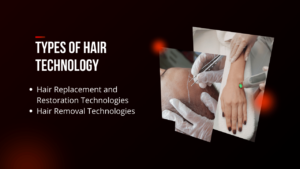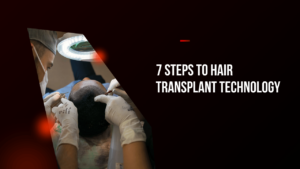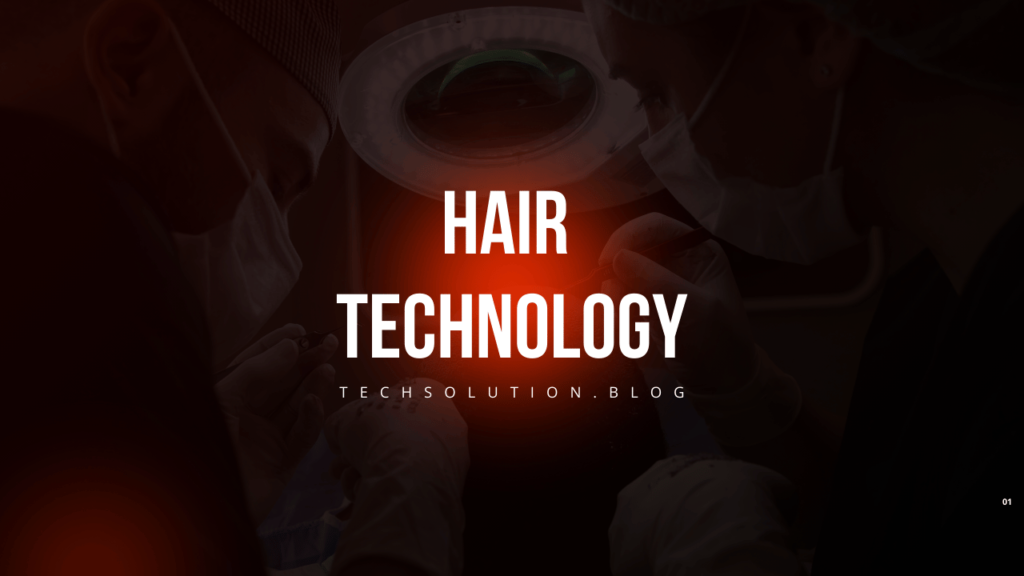Hair technology is revolutionizing the beauty industry, shaping the way we think about hair care, styling, and even restoration. From cutting-edge treatments like laser therapy to advanced tools designed for precision styling, the global hair technology market is projected to reach $40 billion by 2030—a clear indicator of its impact. Whether you’re a stylist, a tech enthusiast, or someone simply curious about how technology is transforming this everyday necessity, this is your gateway to understanding the pros, cons, and innovations redefining hair care.
Imagine tools that analyze your scalp’s health with pinpoint accuracy or machines that replicate natural hair patterns for seamless extensions. It’s not just about aesthetics anymore; it’s science and artistry working together. In this guide, we’ll break down the complexities into actionable insights. Ready to discover the tech behind the tresses?
Let’s dive in!
What is Hair Technology?
Hair technology encompasses a wide range of innovations designed to solve various hair-related issues, including hair loss, hair thinning, and hair removal.
Modern hair technology uses advanced tools and methods, from laser treatments to robotic-assisted hair transplants, to give people the desired results with greater precision and less downtime. These technologies are transforming the hair industry by offering more effective, faster, and less invasive solutions.
Types of Hair Technology

Hair technology can be broadly categorized into two main types: hair replacement/restoration and hair removal technologies. Each has its own subset of innovations designed to address specific hair-related concerns.
1. Hair Replacement and Restoration Technologies
If you’re looking for ways to combat hair loss, the field of hair restoration technology is more advanced than ever. Whether you’re considering a hair transplant, hair replacement system, or hair implants, you now have access to the latest and most effective solutions.
- New Hair Transplant Technology: One of the most exciting developments in hair replacement is the new hair transplant technology, which focuses on precision and minimal invasiveness. The latest hair transplant technology, such as Follicular Unit Extraction (FUE), enables surgeons to harvest and transplant individual hair follicles with minimal scarring. Surgeons have largely replaced older, more invasive techniques that caused noticeable scars with this method.
- New Hair Implant Technology: Hair implants have become more refined with advancements in tools and procedures. The new hair implant technology uses micro-precision instruments that ensure more natural-looking results, faster recovery times, and less discomfort for the patient.
- Latest Hair Replacement Technology: This technology goes beyond implants and transplants, offering advanced solutions like synthetic hair implants and natural-looking wigs made from the finest human hair. The latest hair replacement technology focuses on delivering seamless, undetectable results that allow individuals to regain their confidence.
2. Hair Removal Technologies
Unwanted hair can be a persistent issue, but the field of hair removal has also seen revolutionary improvements. From traditional laser treatments to more advanced laser hair removal systems, the results are more effective and long-lasting.
- Newest Hair Laser Removal Technology: Laser hair removal has become a staple in the beauty industry. However, the newest hair laser removal technology is taking it a step further by providing faster, more comfortable, and safer treatments for all skin types. Innovations such as diode lasers and Intense Pulsed Light (IPL) systems offer a wider range of treatment options, with some devices even being suitable for home use.
- Best Laser Hair Removal Technology: The best laser hair removal technology minimizes discomfort and maximizes results. Advanced cooling systems, precision targeting, and faster treatment times make these systems ideal for both large and small areas of the body. Whether you’re removing hair from your legs, arms, or face, these systems provide lasting results with fewer sessions.
Pros And Cons Of Hair Technology
Pros |
Cons |
| Minimally Invasive Procedures: The latest hair technologies, such as FUE transplants and advanced laser removal systems, minimize pain, reduce recovery times, and lower the risk of scarring. | Cost Can Be High: Advanced hair restoration and removal procedures can be expensive, especially when multiple sessions are required to achieve desired results. |
| Natural-Looking Results: Advanced hair restoration methods, including the latest hair transplant and implant technologies, provide natural-looking results, making it difficult to differentiate between transplanted and natural hair. | Multiple Sessions Required: Multiple treatments are often necessary for optimal results, whether for laser hair removal or hair transplants, which can increase both time and cost. |
| Long-Lasting Hair Removal: Laser hair removal technologies provide long-lasting to even semi-permanent hair removal results, with fewer touch-ups needed. | Not Suitable for Everyone: Some technologies, like laser hair removal, may not work effectively for certain skin types or hair colors, limiting the effectiveness of the treatment. |
| Comfort and Precision: Newer technologies have improved tools, including cooling systems and precision targeting, offering a more comfortable and effective experience. | Side Effects and Risks: Despite advancements, side effects like redness, swelling, and irritation (for laser removal) or infection and scarring (for hair transplants) are possible. |
| Customizable Options: Hair technology offers flexible solutions tailored to individual needs, including different skin types, hair types, and treatment areas. | Results May Vary Based on Individual Factors: Hair density, skin type, and the cause of hair loss can impact the effectiveness of hair technology solutions, meaning results may differ from person to person. |
7 steps to hair transplant technology in 2024

1. Consultation and Assessment
The first step is a thorough consultation with a hair transplant specialist. In 2024, advanced diagnostic tools will assess the patient’s hair loss pattern, scalp condition, and donor area. Virtual simulations may also be employed to help patients visualize potential results.
2. Donor Area Preparation
In the latest hair transplant techniques, such as Follicular Unit Extraction (FUE) or Robotic Hair Transplantation, doctors shave and prepare the donor area (typically the back or sides of the scalp) for follicle extraction. They use advanced numbing agents to ensure minimal discomfort during the process.
3. Hair Follicle Extraction
Using state-of-the-art micro-punch devices, individual hair follicles are extracted from the donor area. In 2024, robotic systems or AI-assisted tools will offer greater precision, ensuring minimal scarring and optimal harvesting without damaging surrounding follicles.
4. Graft Preservation
After extraction, hair follicles are preserved in special solutions to maintain their viability. Cold preservation or biotechnological solutions are now more common to enhance the survival rate of hair grafts.
5. Recipient Site Creation
The recipient area (the balding or thinning region) is numbed, and small incisions are made using precision tools. Modern techniques ensure the new hair’s direction, angle, and density match the natural growth pattern, resulting in a more seamless appearance.
6. Follicle Implantation
The extracted follicles are meticulously implanted into the recipient sites. Advanced AI-assisted devices or robotics can now handle this process more efficiently, reducing the time needed for surgery and improving accuracy.
7. Post-Procedure Care and Recovery
Patients are provided with detailed post-operative care instructions, including the use of regenerative treatments such as Platelet-Rich Plasma (PRP) therapy. These innovations promote faster healing and ensure that transplanted hair grows naturally over time.
The Future of Hair Technology

Hair technology continuously evolves, with researchers and innovators pushing the boundaries of what’s possible. The future holds even more promising advancements in hair restoration and removal techniques.
- Stem Cell-Based Hair Growth: One area showing great potential is using stem cells for hair restoration. Researchers are exploring how stem cells can stimulate hair follicles and promote new growth, potentially offering a solution for individuals who have not succeeded with traditional transplants.
- Robotic Hair Transplants: Robotic systems are becoming increasingly integrated into hair transplant procedures, allowing for even greater precision and faster recovery times. These systems can identify and select the healthiest hair follicles, ensuring a more natural look and feel.
- At-Home Hair Removal Devices: While in-office treatments are still the gold standard, at-home hair removal devices are becoming more sophisticated. New systems are being developed that are just as effective as their professional counterparts, offering consumers more flexibility and convenience.
Conclusion
Regarding the latest advancements in hair technology, there’s no denying that the future is bright. These innovations provide individuals with more effective, long-lasting, and comfortable solutions, from the newest hair laser removal technology to the new hair implant technology. Whether you’re seeking the best laser hair removal technology or the latest hair replacement technology, there is no shortage of options to explore.
As with any medical or cosmetic procedure, it’s essential to research and consult a professional to determine the best course of action for your needs. The pros of hair technology far outweigh the cons, especially as the field continues to evolve and offer even better solutions for people struggling with hair loss, thinning, or unwanted hair. If you’re ready to take the next step, the newest hair technologies are waiting to give you the desired results.



